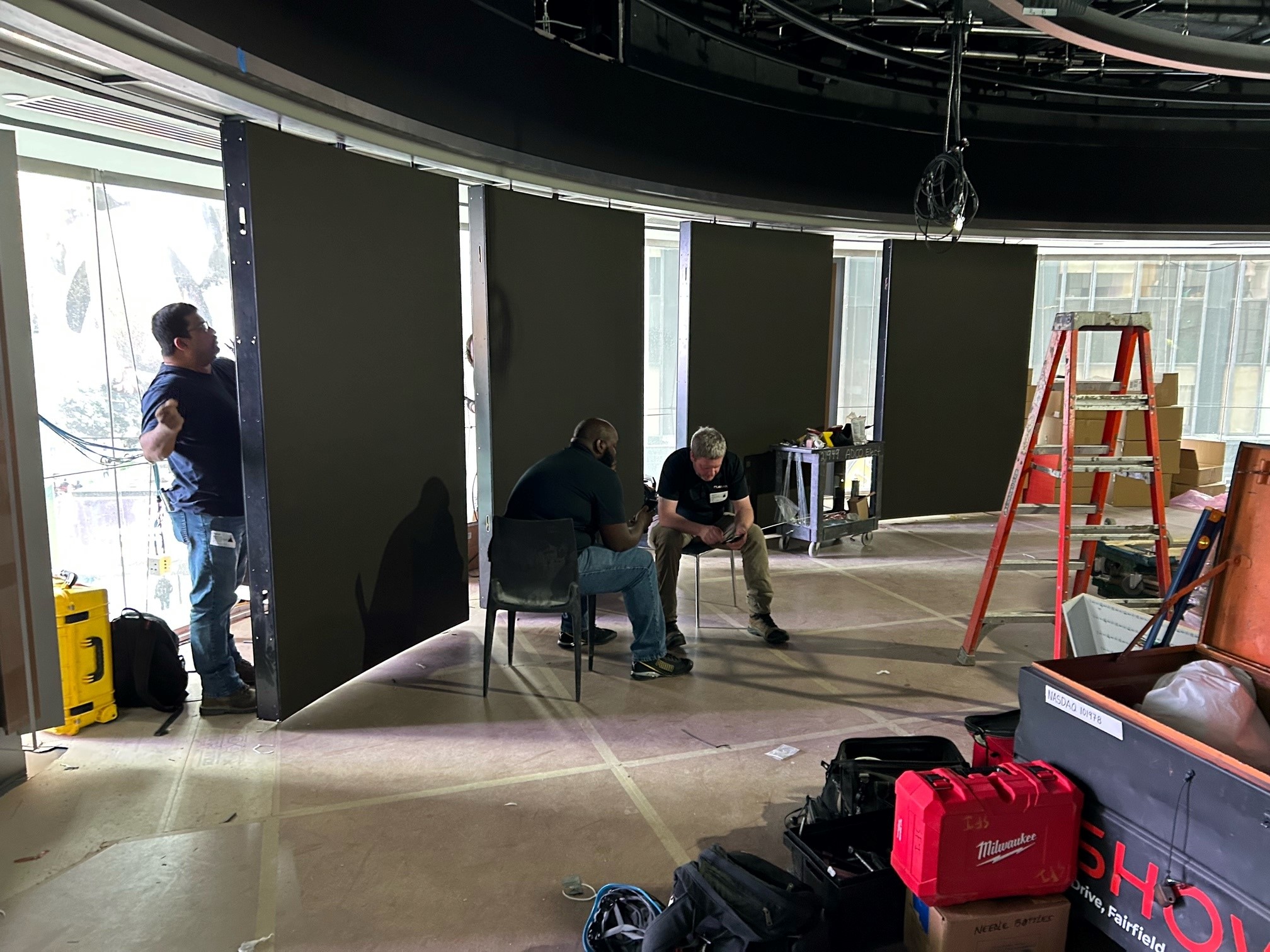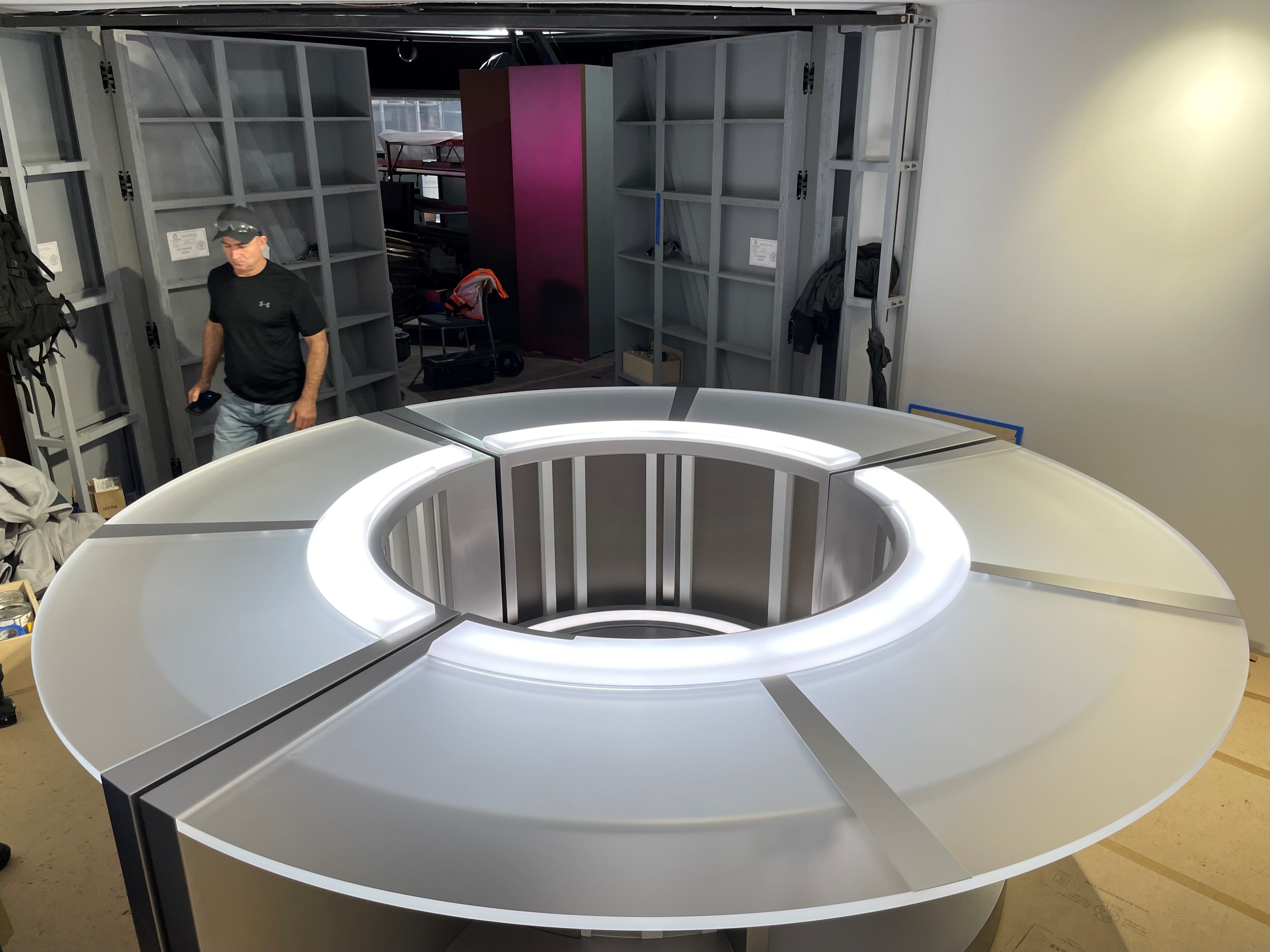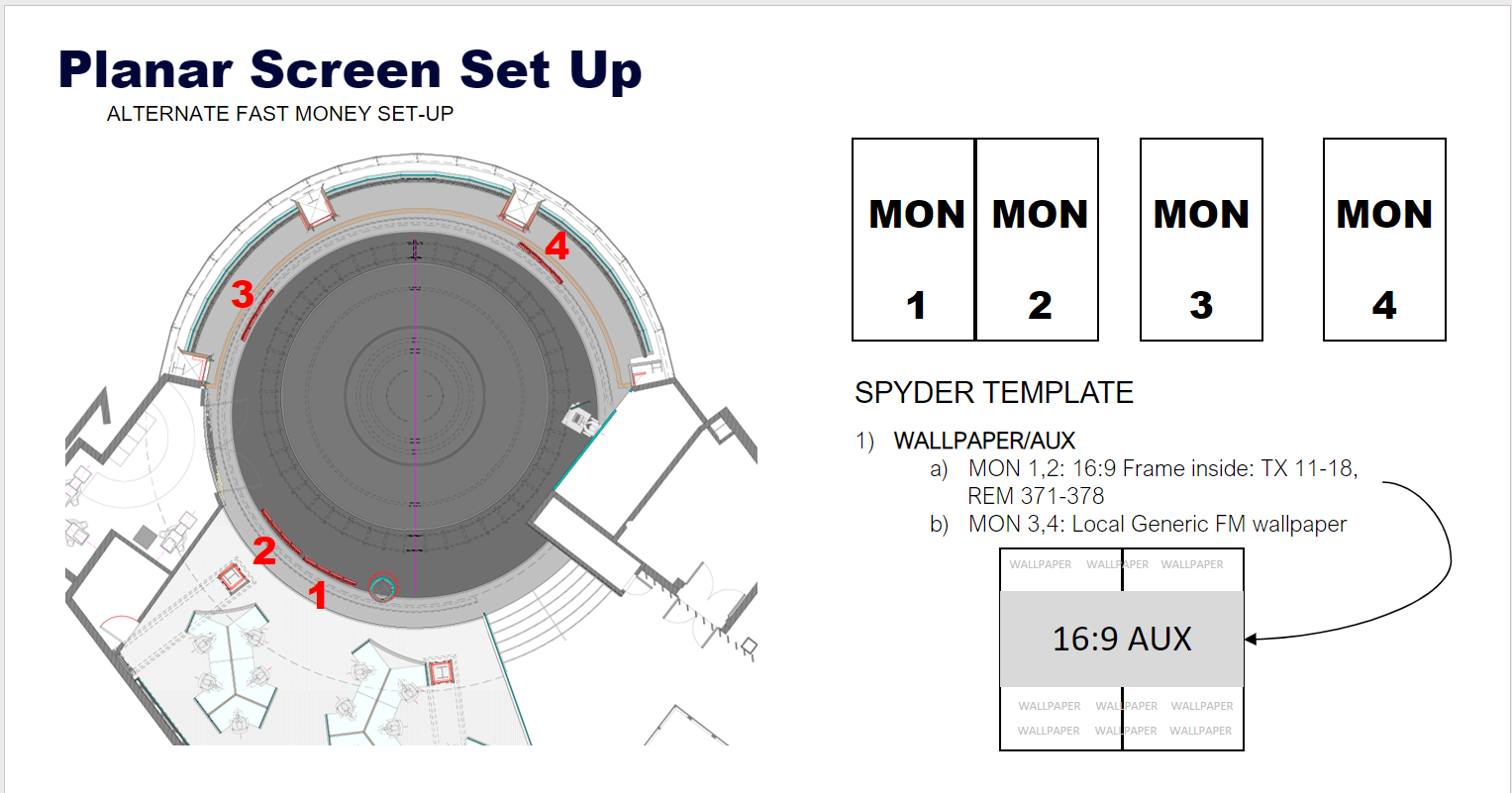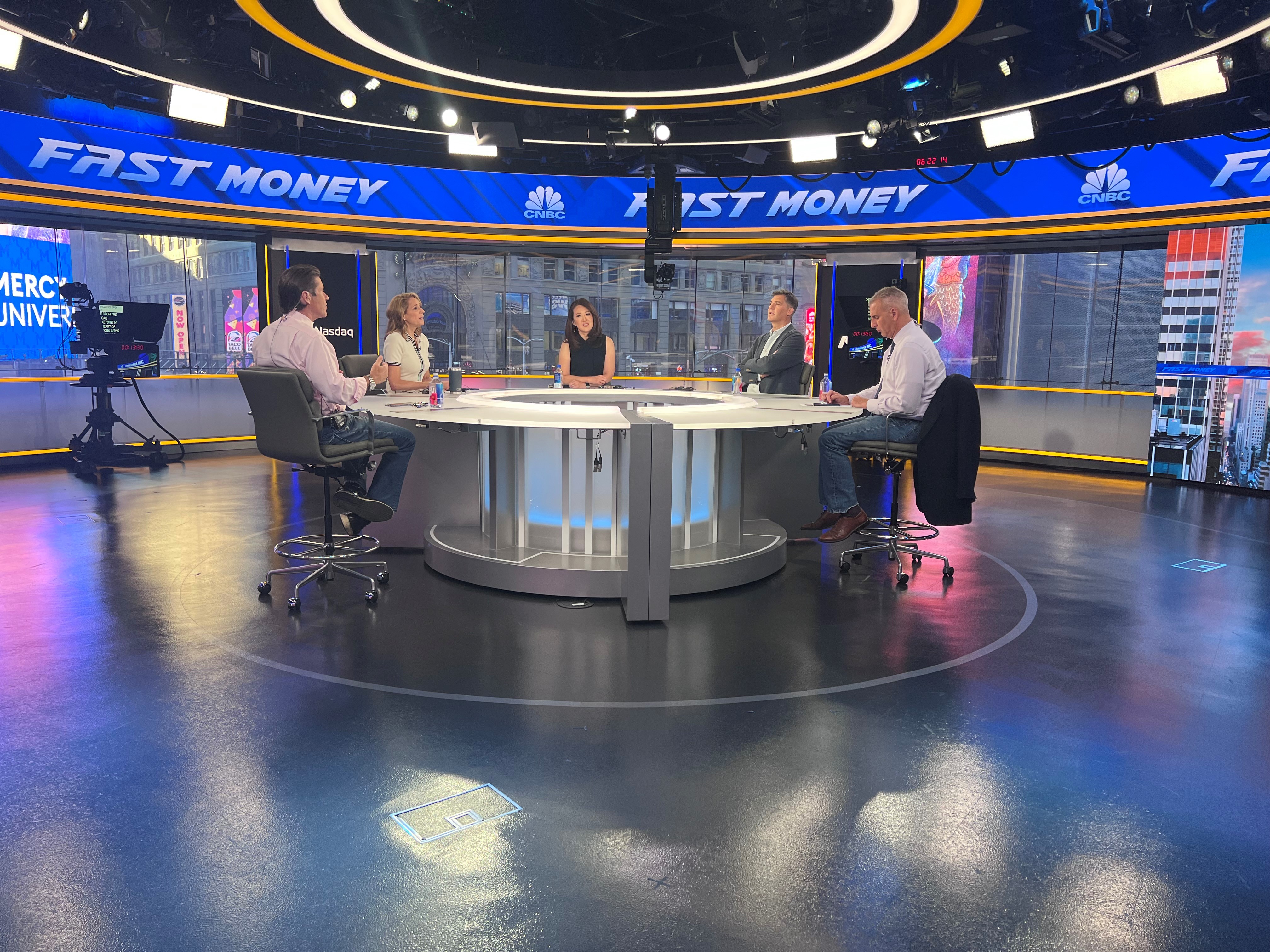CNBC’s New Studio: Taking The Roundabout Way To ‘Fast Money’
CNBC leverages circular camera track and movable LED monitors in the new Nasdaq studio

NEW YORK CITY—CNBC last month debuted its new “Fast Money” studio on the second floor of the Nasdaq MarketSite, a space combining both robotic tracking cameras and tracking LED displays, that’s designed to make it possible for guests and hosts to interact more naturally in a face-to-face setting.
“Anytime you have a panel discussion show with more than one or two hosts, the geometry [of the set] is going to be challenging,” says Steve Fastook, senior vice president of technical and commercial operations at CNBC.
But the new “Fast Money” set design “forces” everyone “into facing each other, which is really great for this type of show,” he says.
The centerpiece of the 30-foot diameter studio is a circular desk built in sections by NBC Telemundo in Miami, specifically designed to be moved each trading day from an adjacent storage space dubbed “the garage” into the studio.
Building the desk in sections on rollers, however, gives the financial network a way to modify its setup based on how many people will be on set any given day.
“What we’ve always hated is sometimes the traders are remote, and if there are only two or three people at the desk, it was a terrible experience to have a massive piece of furniture,” says Fastook. “Now what happens is if it’s just [show host] Melissa [Lee] or Melissa and two traders, we just bring out a section.”
It also makes it easy for the Nasdaq exchange to transform the space to become its First Trade IPO (Initial Public Offering) Center, says Joseph Brantuk, Nasdaq vice president and chief client officer of corporate platforms.
The professional video industry's #1 source for news, trends and product and tech information. Sign up below.
“Our goal was to try and create the most inclusive sort of celebration of that first trade process, which we call the price discovery process,” he says. “So, we have a similarly sort of shaped podium desk.”
While Nasdaq’s desk is not a full circle, like the CNBC desk, it is on rollers so it can be easily wheeled to the center of the round studio so that “hundreds and hundreds” of people can stand in and around it to experience the first trade and watch price discovery come together, he says.
“I generally am the host,” says Brantuk. “I’ll educate them [those present from the company making its IPO], not only congratulate them on the significant milestone. We really use it [the IPO Center] as a way to engage…[and] create this inclusive experience.”
The exchange also uses the space to interview Nasdaq executives and those of its listed companies “to really help amplify and tell their stories,” he adds.
Design and Build
Nasdaq hired broadcast studio designer Jack Morton to design the studio, as well as for lighting design and its desk and podium used for the IPO center. CNBC’s “Fast Money” desk was designed by John Casey Production Design.


Work on the studio began in winter 2022. In January, the second floor of the Nasdaq MarketSite building was shut down so work could begin. The project wrapped up in mid-July, and “Fast Money” went live with a ribbon-cutting ceremony in early September, says Fastook.
All production technology in the studio, including cameras and displays, is owned by Nasdaq.
Round and Round Tech
Two technology elements –movable LED displays and a pair of ceiling-mounted robotic cameras—are key to making production in the round possible. The cameras are affixed to Telemetrics Televator pedestals that descend from the company’s Tele-Glide track system. “The cameras can drive all of the way around [the desk]. What that does is it continues to celebrate the circular experience. They drive in a perfect circle that matches the desk and matches the talent so the point of view is always accurate,” says Fastook.
The cameras are like having two jibs that can go around the studio and raise and lower as needed for shots, he says, adding they respond to control commands in real time and can be flexibly positioned to capture ceiling-height bump shots when needed.


“Honestly, even with a Steadicam, we couldn’t get the shots those Telemetrics get because we couldn’t get high enough—especially those arcing high shots. They look great when you have a bunch of people having a conversation around the table, and you’re able to rotate that shot all the way around. It really brings a nice dynamic to it,” says Fastook.
Complementing the shots are those from six UHD cameras, each locked down around the studio in a location strategically chosen to eliminate their visibility on-air. Each relies on a robotic head for pan, tilt and zoom.
Four movable Planar LED displays, together accounting for 700 square feet of display, are mounted on a track near the outer wall of the studio. Track-mounting gives the broadcaster and Nasdaq the ability to position them strategically as needed.

For instance, behind about 160 degrees of the circular studio are exterior windows giving a view of Time Square in Midtown Manhattan. Having the ability to reposition the panels on the track means the broadcaster can obstruct distracting outdoor elements from shots, says Fastook.
“If there’s a building under construction or some signage that’s too intrusive, we can slide the panels around,” he says.
Another way used to control how intrusive outdoor distractions appear through the windows is polarized lamination from Rosco that makes it possible to adjust the amount of light coming through the windows, such as bright, distracting light from a digital sign across the street, says Fastook.
The LED displays, arranged in a 9 x 16 orientation, can be positioned independently. Rarely are all four locked together because “then it’s just a big screen, and everybody’s got big screens,” he says.
Piano locks on the back sides of the monitors are snugged down a couple of turns to make sure any paired displays are seamless in appearance, says Fastook.
Production crew look in on the studio through a glass wall. There, two operators, one each for the ceiling mounted cameras and the studio cameras, control the cameras and robotics. A “Fast Money” display operator remotely accesses the same Christie Spyder Nasdaq uses to control how its data is displayed around the building and takes control of video, graphics display for the show.
All signals homerun back to CNBC headquarters in Englewood Cliffs, N.J., where the show is produced. “The main reason for that is the complexity of our on-air data and graphics. Everything else is back at home—clip playout, editing and the content management system,” he says.
The studio was designed to minimize the number of wires used. CNBC’s desk is all wireless, including several lighting elements in the desk, and under control from a wireless DMX controller.
The broadcaster even considered powering the lights with ENG batteries, but decided against it because there was already a plug underneath the desk position, says Fastook.
Similarly, audio in the studio is wireless; however, there is some wiring in the bottom of the desk in the event of a wireless failure and emergency mics are required, he adds.
Successful Partnership
Nasdaq owns the studio as well as all of the video production technology in use.
“One of the biggest things for us is that this belongs to Nasdaq,” says Fastook. “This actually shows how good the partnership is that they built something so incredible.”
Brantuk echoes the sentiment. “This studio highlights a great partnership between Nasdaq and CNBC when we think about the technology. But when our customers and our issuers cognizant that, they expect to see cutting edge technology and our working with key partners like CNBC.”
Phil Kurz is a contributing editor to TV Tech. He has written about TV and video technology for more than 30 years and served as editor of three leading industry magazines. He earned a Bachelor of Journalism and a Master’s Degree in Journalism from the University of Missouri-Columbia School of Journalism.



